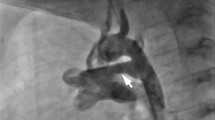Summary
To determine the duration of bidirectional flow through the ductus arteriosus and to confirm the time of functional closure of the ductus arteriosus, 25 normal full-term newborns were studied serially using Doppler color flow imaging beginning at 2–7 h after birth and continuing until no ductal flow was detected (defined as functional closure). At the first examination, blood flow was bidirectional in 19 of 25 infants and continuously left-to-right in the remaining six. Subsequent studies revealed that bidirectional ductal flow changed to continuous left-to-right flow in 17 of 19 infants, whereas two of 19 abolished the flow completely at the second examination. Three of the 19 infants still had bidirectional flow through the ductus arteriosus at 12, 18.5, and 24 h after birth. The percentage of newborns who had bidirectional flow through the ductus arteriosus decreased roughly as a negative exponential function of age. The earliest functional closure of the ductus arteriosus was at 8 h after birth: by 24 hours 44% and by 48 h, 88% were functionally closed. By 72 h of age, the ductus arteriosus was functionally closed in all 25 infants. This study shows that bidirectional flow through the ductus arteriosus changes to continuous left-to-right flow before the functional closure, but can persist up to 24 h after birth.
Similar content being viewed by others
References
Adams FH (1983) Fetal and neonatal circulations. In: Adams FH, Emmanouilides GC (eds)Moss' heart disease in infants, children, and adolescents, 3rd edn. Williams & Wilkins, Baltimore, pp 11–17
Daniels O, Hopman JCW, Stoelinga GBA, Busch HJ, Peer PGM (1982) Doppler flow characteristics in the main pulmonary artery and the LA/Ao ratio before and after ductal closure in healthy newborns.Pediatr Cardiol 3:99–104
Emmanouilides GC, Moss AJ, Duffie ER Jr, Adams FH (1964) Pulmonary arterial pressure changes in human newborn infants from birth to 3 days of age.J Pediatr 65:327–333
Gentile R, Stevenson G, Dooley T, Franklin D, Kawabori I, Pearlman A (1981) Pulsed Doppler echocardiographic determination of time of ductal closure in normal newborn infants.J Pediatr 98:443–448
Gessner I, Krovetz LJ, Benson RW, Prystowsky H, Stenger V, Eitzman DV (1965) Hemodynamic adaptations in the newborn infant.Pediatrics 36:752–762
Huhta JC (1986)Pediatric imaging/Doppler ultrasound of the chest: Extracardiac diagnosis. Lea & Febiger, Philadelphia, pp 101–123
Milne MJ, Sung RYT, Fai Fok T, Crozier IG (1989) Doppler echocardiographic assessment of shunting via the ductus arteriosus in newborn infants.Am J Cardiol 64:102–105
Musewe NN, Smallhorn JF, Benson LN, Burrows PE, Freedom RM (1987) Validation of Doppler-derived pulmonary arterial pressure in patients with ductus arteriosus under different hemodynamic states.Circulation 76:1081–1091
Musewe NN, Poppe D, Smallhorn JF, Hellman J, Whyte H, Smith B, Freedom RM (1990) Doppler echocardiographic measurement of pulmonary artery pressure from ductal Doppler velocities in the newborn.J Am Coll Cardiol 15:446–456
Reller MD, Ziegler ML, Rice MJ, Solin RC, McDonald RW (1988) Duration of ductal shunting in healthy preterm infants: An echocardiographic color flow Doppler study.J Pediatr 112:441–446
Riggs T, Hirschfeld S, Avroy Fanaroff CB, Liebman J (1977) Neonatal circulatory changes: An echocardiographic study.Pediatrics 59:338–344
Rudolph AM (1974)Congenital diseases of the heart: Clinical-physiologic considerations in diagnosis and management. Year Book Medical Publishers, Chicago, pp 476–477
Rudolph AM (1970) The changes in the circulation after birth: Their importance in congenital heart disease.Circulation 41:343–359
Shiraishi H, Yanagisawa M (1987) Pulsed Doppler echocardiographic evaluation of neonatal circulatory changes.Br Heart J 57:161–167
Spach MS, Serwer GA, Anderson PAW, Canent RV Jr, Levin AR (1980) Pulsatile aortopulmonary pressure-flow dynamics of patent ductus arteriosus in patients with various hemodynamic states.Circulation 61:110–122
Takenaka K, Waffarn F, Dabestani A, Gardin JM, Henry WL (1987) A pulsed Doppler echocardiographic study of the postnatal changes in pulmonary artery and ascending aortic flow in normal term newborn infants.Am Heart J 113:759–766
Wilson N, Reed K, Allen HD, Marx GR, Goldberg SJ (1987) Doppler echocardiographic observations of pulmonary and transvalvular velocity changes after birth and during the early neonatal period.Am Heart J 113:750–758
Author information
Authors and Affiliations
Rights and permissions
About this article
Cite this article
Shiraishi, H., Yanagisawa, M. Bidirectional flow through the ductus arteriosus in normal newborns: Evaluation by Doppler color flow imaging. Pediatr Cardiol 12, 201–205 (1991). https://doi.org/10.1007/BF02310566
Issue Date:
DOI: https://doi.org/10.1007/BF02310566




